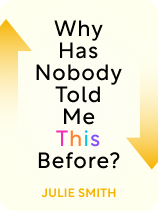

This article is an excerpt from the Shortform book guide to "Why Has Nobody Told Me This Before?" by Julie Smith. Shortform has the world's best summaries and analyses of books you should be reading.
Like this article? Sign up for a free trial here.
Are you often inexplicably down or anxious? Are you eager for a solution that doesn’t involve therapy or medication?
According to Dr. Julie Smith, one of the main reasons people go to therapy is to rid themselves of conditions such as low mood and anxiety. She argues that many people can resolve these matters on their own by understanding them and making certain adjustments.
Continue reading to see whether self-care might be the right solution for you.
Self-Care for Low Mood and Anxiety
Many people experience low mood and anxiety and have resigned themselves to years of intense therapy. Dr. Julie Smith argues that it’s likely you can educate and equip yourself to manage these conditions. Let’s take a look at her insights and recommendations.
Low Mood
There’s a common misconception that if you have frequent low moods, such as depression and sadness, they’re an inherent aspect of your personality, a character flaw, or even a neurological issue. However, Smith explains that, like other emotions, moods aren’t fixed components of our identity—they’re fluctuating sensations in our bodies and minds. Both internal and external factors influence low moods, and understanding these influences empowers us to address the factors we can control and thus steer our emotional well-being in a more positive direction.
Smith explains that low moods aren’t generated solely by your brain or experienced exclusively in your head—your physical state, relationships, history, current circumstances, environment, and lifestyle (diet, exercise, sleep, and so on) all contribute.
How to Shift Your Moods
Smith describes how a vicious cycle keeps us stuck in low moods: Our moods impact our thoughts, which impact our actions, which impact our physical health, which further brings down our moods. To stop this cycle, Smith advises paying attention to your physical state, your thought patterns, your actions, and your human connections.
Your physical state: Low moods can be exacerbated by fatigue, hunger, physical discomfort, insufficient exercise, poor nutrition, and an imbalance in our routines. To support your mood and emotional well-being, work to improve physical factors before addressing things like your thoughts and behaviors.
Your thought patterns: Negative thought patterns, particularly self-critical and repetitive ones, can cause low moods. Smith recommends cultivating self-compassion to help reduce and change negative thought patterns. To tap into self-compassion, ask yourself how you would respond to someone you love who was going through the same things and then respond to yourself in the same way. You can also cut negative thought patterns off by adjusting your physical state—for example, by changing your environment or body position or even raising your hand and telling yourself, “Stop.”
Your actions: Our actions feed our body and brain information about how to feel. When we experience low moods, we often avoid activities that could improve how we feel, and we tend to make short-term choices that ultimately worsen our long-term emotional state. Smith writes that to change your habits and behavior, you should change just a few things at a time. Low moods can make even small, familiar tasks overwhelming, so don’t push yourself to improve too many things at once.
Connection with others: Having positive connections with other people can have a huge positive impact on our mental well-being. Unfortunately, having low moods can make us feel like isolating ourselves from others until we feel better. Isolation can then perpetuate and exacerbate feelings of low mood and depression. Thus, Smith advises that instead of waiting until you feel like socializing, try to make time to be around others even when you don’t feel like it.
Anxiety
Smith explains that anxiety is a physical response we’ve evolved to help us respond to danger—it’s the brain’s alarm signal. Because it works at lightning speed, it doesn’t allow us to evaluate threats calmly. As a result, it frequently triggers fear responses in modern life to situations that aren’t true threats to our survival. We can’t eliminate this survival alarm system nor would we want to—but if we can better understand its workings and identify its triggers, we can learn to differentiate between false alarms and genuine threats.
How to Calm Anxiety
Smith reviews two techniques that can help you calm your anxiety.
Breathe slowly. Anxiety naturally makes us breathe more shallowly and quickly to get more oxygen to our muscles for a quick escape from danger. Slowing your breathing and lengthening your exhales gives your body and brain the signal that everything is OK. Smith recommends doing what she calls “square breathing,” where you inhale for four seconds, hold for four, exhale for four seconds, hold for four, etc. This method helps you make your breathing slower and more even.
Shift your attention away from your anxious thoughts. When you allow your attention to be consumed by anxious thoughts, you communicate to your body and brain that things are not OK, which creates more distress. To interrupt this feedback loop, focus on positive, calm thoughts that can quiet your alarm response—for example, you can say to yourself, “You’re safe, it’s OK. I’m right here with you, and we’ll get through this.” Give yourself kindness and compassion like you would a scared child.

———End of Preview———
Like what you just read? Read the rest of the world's best book summary and analysis of Julie Smith's "Why Has Nobody Told Me This Before?" at Shortform.
Here's what you'll find in our full Why Has Nobody Told Me This Before? summary:
- Practical tips for managing difficult emotions and thoughts
- Why self-compassion is key to mental health and how you can cultivate it
- How to change your relationship with failure






